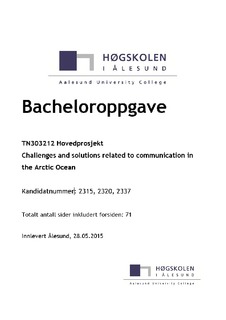| dc.description.abstract | The aim of this bachelor’s thesis is to discuss the problems related to communication in the Arctic and to present solutions that are used on board the vessels and offshore installations operating in the area today. We also investigate the future activity in the Arctic and what kind of communication solutions could be used in the near future.
Traffic in the Arctic is increasing as ice is retracting, new technologies are developing and natural resources are becoming more available. The demand for connectivity is increasing and the communication services provided today are not sufficient. The oil and gas sector represent only a fraction of the vessel traffic in the area, but is at the same time regarded as the main driver for future infrastructure and opportunities. There are potential future solutions solving the communication issues in the Arctic, such as using Unmanned Aerial Vehicles and High Earth Orbit satellites, but these require large initial investments. Satellite communication is the optimal solution for fisheries, cargo- and cruise ships. Satellite coverage will be sufficient for fishing- and cargo vessels sailing below the latitude 74° north, when the new Thor 7 satellite and the Inmarsat 5 satellites become fully operational. The basic operational needs of a cruise ship are also met, but the bandwidth demand from passenger use cannot be met now or even in the near future. Vessels operating in the arctic will have a better SAR connectivity solution with the new Iridium Next satellites, which also cover the extreme Polar Regions. For all vessels, connectivity beyond 74° north is uncertain and the capacity inadequate for any other use than SAR operations and low data communication.
Offshore installations require high bandwidth and thus a fibre optic solution is optimal. Microwave technology could be used, meanwhile satellite communication is regarded by the industry as too slow for Integrated Operations. Redundancy is a must for oil & gas operations, therefore having different technologies available is highly recommended. Offshore vessels and shuttle tankers can use satellites while in transit and then log on to wireless networks provided by the offshore installations. The conclusions presented is a result of researching news, technology articles, business presentations, industry predictions and communication with different players in the offshore communication industry. | nb_NO |

